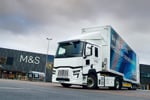WHAT single factor has had the greatest impact on the fleet sector over the past 10 years?
Depending on what type of fleet you operate, the answer is likely to be different, but the sheer breadth of potential responses shows just how many influences affect the company car industry.
The introduction of carbon dioxide based company car tax might be one, as it prompted a huge increase in sales of diesel models. Or maybe it is the price of fuel which has caused such controversy in recent years.
The changing face of the motor industry has been revealed in a set of new figures spanning more than a decade.
Information on issues from the number of cars on UK roads to changes in CO2 performance are covered in the Society of Motor Manufacturers and Traders (SMMT) Motor Industry Facts 2005.
The extensive guide also covers areas such as registration and production data to sector profiles and the rising cost of commodities.
Christopher Macgowan, chief executive at the SMMT, said: ‘Motor Industry Facts – 2005 is a seam of useful information on market and product trends and key safety security and emissions information.’
New registrations –diesel
The last decade has seen a surge in the number of diesels as a percentage of the total market share. Diesels have increased from having a 20% market share in 1995 to just over 30% in 2004. Diesel registrations have more than doubled since 1995 from 405,079 to 835,334 units.
Changes in CO2 performance
Improved CO2 performance has been greatest among new 4x4s and people carriers, which are using 15% and 20% less CO2 respectively than they did in 1997. Other sectors have slashed CO2 emissions, including lower medium, upper medium, executive and luxury sectors – all by more than 10%. The only sector to increase CO2 emission is the sports category, which climbed by more than 5% between 1997 and 2004.
CO2 emissions
The lowest emitting models in each market sector for 2004 are listed, including the Honda Civic petrol-electric hybrid in the lower medium sector and the Audi A6 diesel in the executive category.
Cars on the road
The annual number of cars on UK roads has almost doubled between 1983 and 2004, climbing from 18.6 million in 1983 to an estimated 30.6 million 2004. More than 300,000 superminis left showrooms in 2004 compared with 10 years ago and there were 10.3 million combined new and used car sales in 2004.
Production – sector profile
Although turnover in the motor industry has increased from £42.5 billion in 2000 to £46 billion in 2003, the number of employees in the industry has fallen from 849,100 in 2000 to 830,000 in 2003, showing how vehicle manufacturers are being forced to build more cars cost-effectively to keep front-end prices down.
Fuel duty
Average fuel prices over the past decade have moved steadily skywards. Diesel prices in 1989 stood at just 36.1ppl compared with 82.5ppl in 2004. Unleaded and four-star have similar trends, increasing from 38.5ppl to 80.9ppl and 40ppl to 86.1ppl respectively. The per- centage of pump prices which goes on tax has also climbed steadily. Diesel has increased from 62.8% in 1989 to 72% in 2004, unleaded is up from 59.6% to 73.1% and four-star from 66% to 80.2%.















Login to comment
Comments
No comments have been made yet.